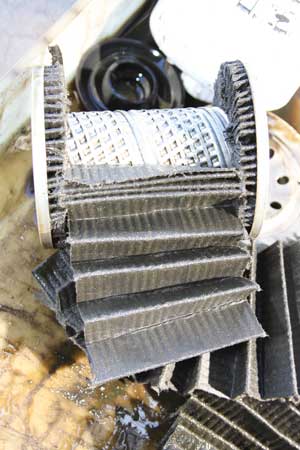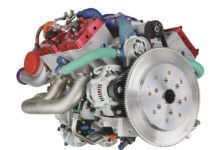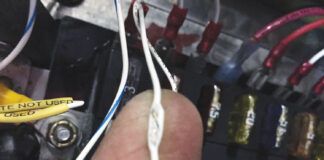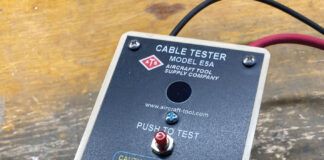
Engine oil filters, whether spin-on or cartridge, are an essential tool in determining the health of an engine. Oil is pumped through the oil filter before coursing out in oil galleys to protect, clean and cool the engine.
Carbon, crud and other contaminants are gathered and swept along by the oil and eventually end up at the lowest part of the oil system: the sump. Contaminant particles that are small enough to pass through the oil pick-up suction screen are captured in the filter. These particles always tell a tale, and it’s always worthwhile to pay attention.
Take It Off
There is an art to removing oil filters without unleashing a tide of lubricant. Why does oil flood out of these filters? Because filters are rarely installed in an upright position.
Most filters are mounted horizontally, at an angle or even upside down. The microsecond the engine-to-filter seal is broken, oil is released, and unless it’s captured the nasty semi-toxic goo will escape and gum up the works. Working up a solution to prevent this from happening is definitely a situation where an ounce of prevention is worth a pound of cure. Here are a few widely used tricks to prevent the dreaded black goo escape.
Cut a length of cardboard that is long enough to carry the draining oil outside of the cowling, allowing it to fall into a bucket. Fold the cardboard in half lengthwise to form a valley, and wedge it in position under the sealing edge of the filter.
Unscrew the filter and let the oil flow.
Another trick that works on the horizontally mounted filters is to cut away half of a plastic beverage or water bottle and position it below the filter. I use a Fiji water bottle that I have modified so that it slides under the filter and rests securely below it.
One trick for upside-down-mounted filters is to punch a hole in the top of the filter can with an awl. The thought is that this breaks the suction on the oil trapped in the can. After letting the oil in the can drain into the engine, a piece of tape is put over the hole and the filter is removed. There are lots of tricks. Find one that works for you.

Removing the pleated filter media from the spool takes patience and a steak knife. Really.
Cutting Open the Filter
So you have the filter off of the engine. Now what? Clamp the nut on the end of the can opposite the sealing end of the filter in a vise. Then use any one of the filter can cutting tools to cut through the can. (See Bob Fritzs review of cutters on Page 54.) Don’t go too fast or you’ll shatter the cutting blade.
When the can is cut clear through, lift out the sealing end of the filter and the element. Let the oil drain off the element. You’ll see fold upon fold of the filter media-it looks a lot like coarse brown paper-captured between a top and a bottom cap. Hidden under the folds of the media is a metal center tube.
Some shops plunge the whole shebang into a can of mineral spirits and swirl it vigorously to dislodge the contaminants. Afterwards, use a strong light and visually inspect the folds of the media. If the look-see doesn’t reveal any remaining contamination, the mineral spirits are poured out and strained through a clean cloth shop rag. This method is faster and less bloody than the cutting-off-the-media method.
Now, the Cutting-Off-the-Media Method
Many shops cut the media off the top and bottom caps and then pull the two ends apart to fully inspect the folds of the media. First, use a pair of diagonal cutters (dykes) to cut through both ends of the metal strip that holds together the two ends of the media. Throw it away.
I use a stiff-blade knife with a serrated edge for cutting the media. These are readily available at most grocery stores. I’ve also used a hacksaw-which works well but shreds the paper-and an ordinary utility knife. Some shops swear by an electric knife for this task. Cutting the media away is somewhat dicey; always maintain a good grip on the filter and stay alert.
Always do an oil filter inspection at every oil change-this combined with compression tests, downloading and reading engine monitor data, and regular oil analyses are the best tools for determining your engine’s health.














